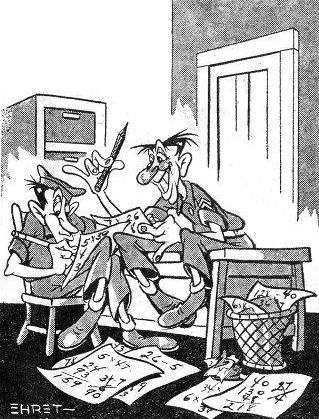Additional personnel of the India-Burma Theater are now moving Stateside through Theater Replacement Depots under the provisions of Theater Circular 105, it was announced this week by Lt. Gen. R. A. Wheeler. Provisions of Circular 105 called for the release from the Theater of all enlisted female personnel with an adjusted rating score of 41 or over and all male enlisted personnel with an adjusted service rating score of 80 or over except those who volunteered to remain. A later Circular, 110, lowered the adjusted rating score to 75 for males and 35 for females. Both this score and the earlier 80 point announcement are based on the score you had as of V-E Day. As soon as possible the Theater will conform with the newly-announced War Department score of 80, which is totaled as of V-J Day. The temporary Theater plan was instituted to utilize the time required to re-compute all scores to keep eligible men on the move and get them to ports of debarkation.
|
|
Emperor's Representatives Sign
Surrender Aboard USS Missouri
While Adm. William Halsey, whose Third Fleet chased the Japs from Hawaii up to Tokyo Bay, glared at the dapper-clad enemy representatives in what Army News Service described as "open contempt," Foreign Minister Mamoru Shigemitsu stepped forth from the ranks of the 11-man Nip delegation and signed on behalf of the Emperor and the Government, to be followed immediately by Gen. Yoshijuro Umezu, who bowed on behalf of the General Staff.
Gen. Douglas MacArthur signed as Supreme Allied Commander. Then came the signatures of Adm. Chester W. Nimitz for the U.S.; Gen. Hsu Yung Chang for China; and Ad. Bruce Fraser for Great Britain. Representatives of Soviet Russia, Australia, Canada, France, Holland and New Zealand followed in that order. Looking on among the Allied staff were two recently rescued POW's, Lt. Gen. Jonathan Wainwright, hero of Bataan, and Lt. Gen. A. E. Percival, who surrendered the British garrison at Singapore.
PROCLAIMS V-J DAY
Following the signing, President Truman spoke from Washington in a world-wide radio broadcast proclaiming Sept. 2 as V-J Day. The president grimly warned the U.S. will never forget Pearl Harbor, and added that neither will the Jap militarists ever forget the USS Missouri. "The evil done by the Japanese warlords can never be repaired or forgotten, but their power to destroy and kill has been taken from them," he said.
After the surrender group aboard the Missouri had heard the message from the Chief Executive of the U.S., MacArthur spoke briefly, saying he would rule with tolerance but would take all measures to see that the terms were carried out.
The Supreme Commander, clad in a open-neck shirt and his familiar old gilt cap, could look around and see the vast pacific Fleet of Adm. Chester W. Nimitz, reinforced by some British warships, dotting Tokyo Bay. Ashore, units of his Eighth Army were moving up to occupational positions and the U.S. Army was already operating Radio Tokyo. The USAAF announced that planes were available to dump immediately 8,000 tons of bombs in case of trouble. There were 10,000 U.S. Marines ashore and 450 British sailors and Marines.
JAPANESE BEHAVING
However, there was no indication that the Japanese would attempt any of their usual tricks of fanaticism and treachery. From all fronts came word that the Nips had either surrendered or were merely awaiting the arrival of Allied emissaries.
Lt. Gen. Tomoyuki Yamashita, ill-famed Tiger of Malaya, gave up his person and Army remnants on Luzon in the Philippines.
Word came from Singapore that the head of the British Far Eastern Fleet, Adm. Sir Arthur Power, has arrived there. Occupations forces are now ready to land. The Nips in SEAC had agreed to the surrender terms at Rangoon. Americans and Chinese had entered Shanghai and the British had gone into Hong Kong, where sniper opposition was reported.
Garrisons in the Solomons, New Guinea and New Britain were surrendering to the Australians. Part of Gen. Joseph W. Stilwell's 10th Army was ordered into Korea for occupational duties in the southern part of the island. On all fronts the picture was of Japs giving up. This was in accord with the surrender terms signed on the Missouri. Here are the terms which Japan agreed to on the U.S. battleship:
(1) Accept all provisions of the Potsdam Declaration.
(2) Surrender unconditionally all armed forces.
(3) Cease hostilities forthwith and preserve and save from damage all ships and aircraft and military and civilian property.
(4) Command Imperial General Headquarters to issue orders to all field commanders everywhere to surrender their forces unconditionally.
(5) See that all civil, military and naval officials obey and carry out the orders of the Supreme Allied Commander.
(6) Carry out in good faith under Allied direction the Potsdam Declaration under which free institutions may be established leading to the restoration of sovereignty.
(7) Liberate all Allied war prisoners and civilian internees and see that they arrive safely at debarkation points.
(8) Acknowledge that the authority of the Emperor and the Japanese Government is subject to the will of the Supreme Commander.
|
BEER RATION DOUBLED
FOR INDIA-BURMA G.I.'S
Release of additional beer by the Quartermaster has permitted the I-B Post Exchange service to raise the individual beer ration to two cases per month, it was announced this week by Maj. K. L. Kepley, Theater Exchange Officer.
The double ration has been authorized as of now and by the time these lines reach you, your Post Exchange will already have received the notification.
The Theater Exchange Officer states unit Exchange officers can go to supply depots and draw another case for each individual for September.
27 Million Left Homes In U.S.
WASHINGTON - (ANS) - More than 27,000,000 Americans left their homes, either as civilian migrants or as members of the Armed Forces, during the period from December 1941 to March 1945, the U.S. Census Bureau reported this week.
Placing the figure for civilian migrants alone at 15,300,000, the Bureau's report stated, "Never before in the history of our country has there been so great a shuffling and redistribution of the population in so short a time."
Estimates showed that on March, 12 percent of the nation's civilian population was living outside its home counties occupied on Dec. 7, 1941. Nearly 7,800,000 had crossed State lines and about 3,600,000 migrated from one to another of the three major regions - North, South and West.
Long distance migration of civilians was predominantly westward, the Bureau said. The West made a net gain of about 1,200,000 in civilian population in the exchange of migrants with other regions. The South lost about 900,000 and the North about 300,000.
Peacetime Army Recruiting Drive Planned In I-BT
Roundup Staff Article
India-Burma Theater this week swung into line behind the worldwide Regular Army recruiting campaign to obtain the maximum number of three-year enlistments in order to secure the peace, now that the war has been won.
Col. Frank Milani, India-Burma Theater Adjutant General, announced that enlistment forms are shortly expected to be distributed to recruiting officers to be appointed soon.
The Army will be able to offer "very attractive" inducements for men to enlist for peacetime duty, Brig. Gen. Harold N. Gilbert, director of the newly-organized Military Personnel Procurement Service, announced in Washington this week.
NOT FULLY DISCLOSED
Gilbert did not immediately disclose the full scope of the inducements, but stated that favorable measures are in process of development and that it is expected that they, along with possible legislative changes, will provide the Army with the most favorable prospects it has ever had. These inducements, declared the general, are being developed "not just for today but for years to come."
Present advantages stored up for Regular Army enlistees are mustering out pay under the G.I. Bill of Rights, right to choose a branch of service and overseas theater, and three-month furlough at home.
Immediate temporary promotion to present grade above private is limited to enlistment or re-enlistment in the same arm of service in which a soldier is now serving.
The War Department emphasized that re-enlistment will be accompanied by the prompt granting of the Three-month furlough which is exclusive of travel time and which does not replace the ordinary annual furloughs.
|
FEW LIMITATIONS
Enlistment in the Regular Army of physically-qualified male citizens of the United States without previous service and between the ages of 18 and 34 years, inclusive is subject to a few limitations. Puerto Ricans may be re-enlisted only for their present organization or organizations presently manned by Puerto Ricans. Filipinos with previous service in the Regular Army may be re-enlisted for the Regular Army. Enlistment of other Filipinos, however, will be for the Philippine Scouts for duty in the Philippines. Negroes may be enlisted in their present organizations which are presently manned by Negroes.
Gilbert, in an interview with International News Service, cited "the need for a larger Regular Army" and said he anticipated many thousand voluntary enlistments after all men in overseas theaters had become fully acquainted with the present incentives.
The War Department stressed the need for "seeing the job through," travel and education benefits, opportunity for a career and the obligation of the United States, as a "guardian of victory," to maintain an effective military establishment.
POW'S TELL OF TERRORS
Roundup Staff Article
Grim reports this week from the U.S. hospital ships Benevolence and Ancon, anchored in Tokyo Bay, told of brutal, sadistic treatment accorded American prisoners of war by their Japanese captors.
On board Benevolence, two liberated doctors - M. L. Gottleib, captured on Guam, and Harold W. Keschner, seized on Bataan - related that at least 23,000 of the 30,000 American troops taken in the Far East have died, many of them in POW camps, where their bodies were cremated on spits and Japanese doctors conducted sadistic "medical experiments."
The reports were substantiated in part by Capt. Qisikichi, medical officer in charge of the Shinagawa Hospital, who admitted that patients were given one treatment consisting of placing a burning ball of grass on a wound.
The two American doctors told how the Japs had tortured U.S. fliers by jabbing splinters under their fingernails, pouring incense-like powder into open wounds and then setting it afire, and injecting mixtures of acid and bile drained from gall bladders into tubercular patients in an effort to find a cure.
Emaciated and starving, 1,000 or more Allied prisoners of war reached the Ancon, off Yokosuka. They had spent months in solitary confinement under constant threat of death. Navy Cmdr. Harold Stassen, former Minnesota governor, reported 80 percent of them showed "serious deficiencies."
Pipeliners Delivered 120,000,000 Gallons by July
|
By SGT. RAY HOWARD Roundup Field Correspondent
LEDO, ASSAM - In the building of the world's longest pipeline, Calcutta to China, necessity mothered so many inventions and so much improvisation that nothing seemed impossible to pipeline engineers by the time victory finally rolled around.
Located at the very end of the world's longest supply line, the pipeliner's ingenuity was in large measure responsible for the delivery by July 30 of this year of 120,139,192 gallons of petroleum products through the pipeline system to the fighters, road builders, and convoys traveling the Stilwell Road.
Few records have been kept of devises conjured by the pipeline engineers, but Col. Birney K. Morse, Swarthmore, Pa., pipeline engineer for Advance Section, admits that ingenuity as much as anything else is responsible for the record construction job.
Back as far as May 1944, a group of pipeliners were camped on the south bank of the Tawang River in Burma, cut off by monsoon floods from their supply base at Shingbwiyang. Outboard motors could not successfully buck the torrential flood and pipeline construction faced a halt unless transportation could be devised.
MAKE POWER BOAT
At hand was a wrecked Bren gun carrier, of no use against the flood but containing a good V-8 motor, plenty of armor plate, and many parts which a manufacturing mechanic might find useful in the jungle. The pipeliners obtained a ten-ton aluminum boat from a neighboring ponton company, mounted the motor in the center and began to construct an inboard boat.
A driveshaft and universal was salvaged from a 6x6 cargo truck, run through the stern of the boat, placed in a piece of 4-inch combat pipe with a bearing on the end of the pipe made from a second-hand truck pillow block, and sealed with regular truck seal grease. The steering device was cut from the end of the gun carrier, and the gun's steering wheel was transferred to the boat. With an acetylene torch, the men cut the propeller from a piece of the gun's armor and hand-hammered it to perfection.
Completed, the boat was able to navigate the Tawang's 1,000-foot span of rushing water, could haul 40 joints of pipe, or three and one-half tons of cargo, or carry 42 men. When last seen it was still in operation on the Irrawaddy River near Myitkyina.
JUST LIKE LOGS
Transportation always taxed the ingenuity of the soldiers. In China, a G.I. with logging experience thought that pipe should be hauled in the same manner that logs are hauled in the Pacific Northwest. He pointed out that the pipe overhanging from the back of an Army 2½ ton truck was hard on the truck, and not very efficient anyway. He soon convinced his company that he could build a semi-trailer, and he did.
Fifth wheels were obtained from an old Chinese stock dump along the Burma Road and mounted on the back of a regular truck from which the body had been removed. A regular 2½-ton engineer trailer was lengthened and strengthened, and two truck bodies were welded together and mounted on it.
The completed semi-trailer looked like a custom built job, and whereas 68 joints of pipe had been previously hauled, the new trailer was able to handle 178 joints. It was found that equalization of the load lengthened the life of the truck, and now all pipeline companies operating along the steep grades of the Burma Road have equipped themselves with this type of trailer.
JEEP CAPACITY: 18
Even to move personnel in China is often difficult. One pipeline company found that by taking two wrecked jeeps, extending the frame and crankshaft, an entirely new vehicle could be made which would transport eighteen men over the rough roads in maximum comfort.
Once when the monsoon had flooded an area near Kaimang where the pipeline was to go, it was found that the country to be traversed was covered by four to six feet of water. Needless to say, pipe could not be coupled in such a lake. Unperturbed, the pipeliners coupled the pipe into 600-foot sections, plugged the ends so
|
In the same vicinity, trucks were unable to cross the muddy flat lands, so pipe sleds were built from heavyweight pipe and Japanese steel plate, enabling huge tractors to pull several tons of pipe for stringing direct from the sleds.
PIPE BENDER
Often it was necessary to bend pipe in the jungle to fit the rugged terrain. Lightweight invasion type pipe could be bent by hand, but the method was haphazard, and many joints were crimped so that they were unsuitable for use. The factor of chance was taken out of the bending method when a man found that the hydraulic lifting mechanism could be taken from a wrecked dump truck, fitted with a curbed metal show, mounted on a light trailer made from reinforced heavy pipe, and used to bend the pipe at any desired angle.
One man could easily operate the bending device, and it was so light that the men could pull it through the jungle where a truck or jeep could never go.
In some places it became necessary to get pipe and supplies into the jungle trace over raging rivers which could not be crossed. To accomplish this, cables were placed across the inaccessible places, and supplies were trollied over in slings. To get pipe over the Loglai River into the jungle, a cable 1,000 feet long was suspended 400 feet over the stream, and was used to move personnel and equipment across.
CUTTING WITH LOG
When the pipe crossed under a river it had to be buried, or it would be crushed by rocks and debris coming down the stream. Engineers had no method of ditching through the swift torrents until someone thought to borrow a 2½-yard shovel from a road engineer company, connect cables to it, and winch it back and forward until a ditch several feet deep was gouged out of the river beds.
Pipeline trace could be cut through the dense jungle with axes and machetes, but in the Mogaung Valley, elephant grass 14 feet high was found more difficult to clear. One day a pipeline truck driver conceived the idea of tying a huge teakwood log to the back of his truck and dragging it along behind the surveyors. The brittle grass snapped at its roots, and in a few days was ready to be burned.
The G.I.'s armed and equipped a jeep-powered train so that pipe could be hauled, strung, and coupled direct from the Mogaung-Myitkyina railway.
JAP FOUNDATION
In the monsoon-soaked flat lands, where pump station and storage tank foundations posed a problem, the pipeline engineers found that discarded Japanese 150-mm shell cases made an excellent foundation surface when sunk into the mud until the base of the shell would go no farther. Ties from an abandoned narrow gauge plantation railroad in the area supplied all lumber needed for cribbing purposes.
One of the most spectacular bridges anywhere along the Stilwell Road is a foot bridge built by pipeline engineers to span the Salween Gorge. It is 700 feet long, and is built entirely of salvaged Japanese and Chinese abandoned equipment. The pipeline crossing is valued at several thousand dollars, but cost the Army nothing but the time of the soldiers who built it.
Many of the tools used were manufactured by the pipeliners in their own machine shops. Some coupling wrenches were made from 1-inch galvanized pipe. Pipe tongs were made from angle iron. A small frame weighing less than five pounds was devised by one company which almost automatically butts the pipe and aligns it so that it can be coupled with a minimum of heavy lifting. Even a complicated mercuoid control switch system has been so simplified by the pipeliners that one set furnished from the States furnished enough material for two complete switches.
GASKET ADJUSTER
Gaskets which cement the openings between joints of pipe are of exceptionally hard rubber, and are difficult to slide into place. Someone perfected a tool which mechanically does the job with a simple twist of the wrist. Thousands of pairs of gloves were worn out before the gadget came into general use.
In the bolted steel tanks, where one plate overlaps another, a special wicking was prescribed to prevent leaks. When no such wicking was available,
|
At one advance base a filling station was to be built, but there was no storage tank available. gasoline drums were welded together, totem pole fashion, and fuel was dispensed directly from the drums.
DRUM DECANTER
A rather peculiar situation developed at one huge POL dump near Ledo. Perhaps a million gallons of gasoline were stored in drums around the area but the pipeline was out of 80-octane gasoline and would have to be shut down unless that stored could be put into the line. In three days the G.I.'s had built a drum decanting plant capable of dumping several thousand barrels of stored gasoline into the line. later, this plant was put to the practical use of relieving part of the pipeline system for other use, and several million gallons of gasoline have arrived by rail to go out through the line.
At Myitkyina, thousands of drums were needed to supply advance bases not located on the pipeline. The drums were available, but most of them were leaky and unsuitable for use. To weld on a gasoline contaminated drum is like playing with an atomic bomb, so a safe method of repair was sought. Soon the pipeliners had repaired a bullet-riddled boiler taken from a sugar mill, and were steam cleaning thousands of barrels for repair.
NOT ALL PIPELINE
All of the ingenuity displayed along the pipeline didn't go directly into pipeline work. The gasoline jockeys have never missed an opportunity to make themselves more comfortable, which takes a lot of imagination in either Burma or China. One detachment built a water supply system which furnished running water for every tent. Not long after the fall of Myitkyina, an imaginative soldier found some parts in the city's wreckage with which he built an ice plant which was soon furnishing 1,600 pounds of ice per day for his company - and in the process was heating enough water for use in the showers.
Ingenuity may be a trite expression, but it is a highly profitable and commendable trait with the boys who built the "longest damn pipeline ever built."
|
Find Changed World
By Sgt. FRED FRIENDLY Roundup Field Correspondent
KUNMING, CHINA - There is a Pfc. in the Marine Corps who never heard of Guadalcanal, or Gen. Patton, or Spam, or even our old friend, Sad sack. For on Dec. 23, 1941, he lost touch with everything that is America.
I met him just after he stepped off the plane from a prison camp at Peiping. When I asked him where he had been captured, he blushed and much like a guy who comes from a place you never heard of said, "I was on a place called Wake. It's in the Central Pacific." I assured him we knew where Wake is.
He would not believe me when I told him a hit movie had been produced on the subject, Wake Island, and when finally convinced, he mused, "I might have to see that." When I asked him if the Wake Marines had really sent the now famous message, "Send us more Japs," he grinned again, bit off a hunk of the first Yankee cake he had eaten in four years and said, "You're damn right we sent it and we wished we never had. We caught holy hell that last day. I never thought we'd leave the island alive."
After leaving Wake, he was at Jap prison camps at Yokohama, Woosaug, Shanghai and Peiping. His first genuine clue that the war must be ending came about two months ago when the Japs marched him into Peiping from the camp outside the town and quartered him in a lavish hotel and began feeding him decent food. In those two months he gained 15 pounds. Two weeks ago, a Jap guard came to the Leatherneck and said, "Japanese and your country no more war, now we are friends," but his outstretched hand hung unclasped.
He was 23 when Wake fell. Now he's not sure as to just what he wants to do after the war. I told him about the G.I. Bill of Rights and he seemed interested in the prospect of going back to school, but became embarrassed when he was forced to say, "I may be a little dense but what is a G.I.?" He had six fried eggs for breakfast and vomited because his stomach wasn't used to that kind of food. His home is in Pennsylvania and he ought to be there by the time you read this story.
Later in the evening, we chatted with a dark-eyed, nervous young captain named Gus Francis, of Salt Lake City, San Francisco and a place called Bataan. The captain continuously smoked a pipe which he has had ever since that long losing fight on Luzon. A Filipino gave it to him and he kept it with him all through the dark days of defeat and imprisonment.
Francis was one of the victims of the Bataan Death march and spent most of his imprisonment at Mukden, Manchuria. I asked him if he was there when our B-29's raided the airplane factories in Mukden. He said it was a magnificent sight watching the Superforts come over, but that seven interned Americans were killed during the raid.
Col. J. R. Manees was another valiant member of Bataan's lost cause. A member of the Inspector General's Branch and once Gen. Douglas MacArthur's I.G., he asked who was Inspector General in Washington now. When I told him, he said he thought he knew Gen. Dan I. Sultan.
Manees asked a lot of questions about different officers and was amazed to hear of lieutenant colonels who are now lieutenant generals and of officers who were once his subordinates but who now ranked him by several grades. Thin, gray-haired Manees was a full colonel in 1941.
A Wake civilian carpenter from Nebraska said that the biggest thrill of his life occurred last Easter, when three P-51's raided Shanghai and destroyed 27 Jap planes and damaged three airfields. He said that the day after the B-29's first raided Shanghai, the Jap general called all the Americans and said, "Yesterday you have seen your first American bombers. We are very sad and you are very glad. Now I suggest you go back to work and say nothing."
Maj. Eugene Jacobs, from Chicago, a surgeon with the 14th Infantry on Bataan, had read about penicillin in a copy of the Reader's Digest and was interested in finding someone who could tell him more about this and the other wonder drugs of the war.
The O'Henry ending of the evening was enacted when a Red Cross girl, Jean Bowyer, almost dropped a tray of food as she entered the upstairs dining room at the Kunming Red Cross club and saw a familiar face from Abilene, Tex. There, big as life, was Lt. A. W. Balfantz, with whom she had grown up and gone to school. He had been a P-40 pilot when our Air Force had "too little, too late" and was captured at Corregidor with "Skinny" Wainwright.
It was a memorable night spent with truly great men who asked about milk and Broadway, about the Golden gate, and was Roosevelt really dead like the Japs said, and what is Truman like, and who is Nimitz, and what is a C-54, and what's the fastest route to the United States.
Japs Dangerous, Says Chennault
MIAMI, FLA. - (UP) - Maj. Gen. Claire L. Chennault, former chief of the 14th Air Force in China, said this week there is "a danger" the Jap Imperial family would be able to re-establish Japan's military strength and again seek world conquest.
The general said this would be possible if Americans become sympathetic with a beaten people. He said it was his opinion that the Emperor must attempt to rebuild Japan's military structure or otherwise cease to exist.
"The Jap structure," said Chennault, "has the mass of the common people at the bottom indoctrinated with the idea that the Emperor is God and his mission is to rule the world. Next is the commercial class, which is the only class that might prevail so that it can continue making money. Then there is the professional and military class, which lives and dies by the code of the warrior.
"The Emperor is at the top and he would have no structure to support him if he removed the warrior clique. There will either be a popular revolution by the commercial class or the Emperor will rebuild for conquest."
I-B TO MANILA ATC AIR LINE
CALCUTTA - The last link in the U.S. Army's round-the-world chain of airways, a link forged during the most strenuous days of the struggle against Japan and hitherto a top military secret, may now be revealed.
For nearly nine months, planes of India-China Division of the Air Transport Command, have flown across Jap lines from advance bases in China straight to the Philippines, cutting Calcutta-to-Manila time from about 50 hours (by way of Ceylon and Australia), first to 12½ hours and recently to less than eight hours.
U.S.-to-Calcutta flying time, usually more than 65 hours by way of African and Atlantic routes, has been reduced to the neighborhood of 40 hours by routes continuing from Manila across the Pacific.
In the initial run, from Kunming to Leyte, Free China was connected with bases of the Allies in the Pacific, by other means than radio, for the first time since the Japanese seizure of coastal areas early in the war.
The new route was pioneered in an experimental flight by Lt. Col. (then Major) Robert D. Forman, of Memphis, Tenn., director of training in the Air Transport Command's India-China Division, on Nov. 27, 1944. He landed his B-24 Liberator bomber at Leyte in the Philippines around noon of that day, 12½ hours after taking off from China. The historic flight covered 1,800 miles.
Forman's co-pilot was Capt. Jasper W. Woodruff of Fayetteville, Ark. The navigator was Capt. Daniel Wolf of Flushing, N.Y.
|
LIAISON CRAFT CROSS HUMP IN MASS FLIGHT FROM INDIA TO CHINA |
HQS., 10TH AIR FORCE - Thirty tiny liaison planes recently set out on a mass flight over The Hump to China, with 29 of them arriving safely at Kunming to successfully complete a flight over terrain that has balked twin-engined transports.
On the 13th and 14th of June, 1945, flights of 10 L-5's departed from a USAAF base near Calcutta, and flew by stages to the northern part of the Assam Valley. The formation was under the command of Maj. William Hawkins of Pixley, Calif., Group Operations Officer, who as a veteran fighter pilot of the China Theater was familiar with the tortuous routes.
Surprisingly, the closest L-5's came to disaster was early in the trip when the first flight, struggling through blinding rain, ran low on gas 12 miles short of their base. With a ripping of wing tips and snapping of telephone wires the little planes landed on a muddy country road near an unknown Indian Village.
TAKE OFF ON ROAD
Reinforced with gas from the other ships, Lt. Donald T. Carter of New York City, took off from the road between trees and poles to get help from the base. Meanwhile, Hawkins rode in a commandeered truck to the nearest town where he located a civilian gas dump.
The next day the wings of the damaged planes were patched and the first flight flew on up the Assam Valley where new wings were installed. One of the worst parts of the trip was just ahead, the 240-mile run over the 9,000-foot Naga Hills. The monsoon was drenching all of North Burma and the weather over the hills was something out of this world. There was only one way to get through: contact flying through the dense jungle valley - a few feet above the ground.
EAT 'C' RATIONS
With one eye on the gas gauge and the other on the tree tops, the "L" pilots twisted and turned battling the relentless weather. Once over the ridges, it closed in tight, and hawkins' flight was forced to land on an abandoned spur of the Ledo Road. Here they were fortunate enough to run into a small ebgineer detachment and a "C" Ration lunch. In the afternoon the weather cleared to about 500 feet visibility and the flight went on. All three flights arrived safely at another field and refueled for the flight over The Hump.
Early in the morning of June 16th, Hawkins set off at the head of the first 20 grasshoppers on the final lap to Western China.
The first flight was under Carter and the second 10 were under Lt. John F. Mevins, Corsicana, Tex.
But the last flight under Lt. Benedict Lukacs of Syracuse, N.Y. had a harder battle, tougher luck, and narrower escapes.
Over the Naga Hills the engine sputtered and started to miss on the plane piloted by S/Sgt. Robert McGovern of Langhorne, Pa. There was a terrible half-hour while McGovern struggled to clear the last 9,000-foot ridge, as his flight mates sweated him out.
In Northern Burma the flight's troubles really started. The weather was getting worse every day and it hit the pilots with all its fury on the first leg from Burma to China. One hundred and fifty miles out over The Hump the planes became separated in a thunderstorm and seven made their way back. The other three were missing. The pilots were M/Sgt. Bill Oldaker of Chattanooga, Tenn., T/Sgt. John Raynak of Claridge, Pa., and S/Sgt. Lee East of Highland Park, Ill.
No word had been received of the missing pilots the next morning. On the 21st the seven planes made their last, and this time successful, effort to clear The Hump. Fighting storms which whirled the tiny ships like autumn leaves, Lukacs and his men arrived in Kunming.
There the flight was amazed and relieved to find two of their missing pilots, M/Sgt. Oldaker and T/Sgt. Raynak, waiting for them. They had bored through successfully on the 18th after the rest of the flight had turned back. Then several days later East, who had been given up for lost, walked in. He had spun out of the clouds 200 feet above the ground and recovered sufficient control to make a crash landing. He walked 50 miles to safety.
|
Snafued Pearl Harbor
The morning of Dec. 7 at Pearl Harbor a private on the radar equipment told a second lieutenant that unidentified planes were approaching the great U.S. Pacific bastion.
The officer curtly told the private to "forget it." So the Jap planes came in against an un-alerted and unprepared foe.
NOW LIEUTENANT COLONEL
The United Press revealed this week that the lieutenant, Kermit A. Tyler, of Iowa, has been promoted steadily since that day and has reached the rank of lieutenant colonel. This steady climb on the promotion ladder resulted, even though the Army Pearl Harbor Inquiry Board found he had performed an "indefensible" action, when he advised the private to disregard the planes.
The alert private was Joseph Lockard, of Williamsport, Pa., now a first lieutenant. Lockard was only at the radar machine, normally unmanned at that hour, to satisfy the curiosity of Pvt. George Elliott of Elmhurst, Ill., now a sergeant.
THERE FOR TRAINING
United Press stated that Tyler told the inquiry board that he was merely there for training and had no knowledge on which to base any action. The board had stated, "Yet he assumed direction as to what action should be taken instead of seeking someone competent to make a decision."
|
'Sneak' Attack Details Told
WASHINGTON - (UP) - Now that the debt has been paid, the Navy this week revealed how the Japanese struck Pearl Harbor on Dec. 7, 1941.
The enemy fleet, consisting of six fast carriers, two battleships, two heavy cruisers, one light cruiser and a destroyer division, assembled in the home waters in November 1941. On Nov. 22 they steamed to Tankan Bay at Etorufu Island in northern Japan.
This task force, which began training in July or August, left Tankan Bay on Nov. 27 and 28. Taking a northerly route south of the Aleutians to avoid being sighted by U.S. shipping, it headed due east to a point substantially north of Hawaii. It then proceeded south to a point 250 to 300 miles from Oahu, where 300 carrier planes were sent to Pearl Harbor.
Meanwhile, large submarines with midget subs secured to the top decks operated off Hawaii. A few days before the attack, five of these tiny two-man subs were released and at least two of them entered the harbor when the anti-sub net was lowered for incoming and outgoing garbage scows.
|
ABOARD A B-29 OVER NAGASAKI - (UP) - Nagasaki, victim of the atomic bomb, today lies bare, brown and lifeless.
Flying at a low altitude, you can see where Nagasaki was, but you can't see Nagasaki. In its place is a wide brown patch, two or three miles wide and littered with debris.
The city is hard to describe because there is so little left of it. The sharpest impression is of brownness; result of the searing atomic heat which withered every green plant for miles around and consumed every scrap of wood.
Approaching the city, we flew over some grey-topped houses. Then suddenly we noticed there were no more houses, no buildings, no structure of any kind left standing, just barren-wreckage-littered ground. To the left rose blackened smokestacks. An adjacent factory was a scattered pile of twisted girders. A curious small steel and concrete bridge about 100 yards from the factory was undamaged. Two or three people were walking across, staring up in curiosity at our plane.
Here and there, amid desolation, a modern building stood, its roof gone and the interior burned out.
|
SAN FRANCISCO - (ANS) - Nearly 10,000,000 persons, one-sixth of the population of Japan's home islands, were killed, wounded or made homeless by U.S. air attacks during the war, Tokyo radio announced this week. |
The entire northern industrial center of the town was leveled. Not a single dock or warehouse was to be seen. I was unable to find on which bank of the river that divides Nagasaki the bomb fell. Apparently it made little difference - destruction was complete.
Two I-B Soldiers Knock Out Tiger with One Volley
Roundup Staff Article
Comes now another G.I. tiger hunt story, this time involving Sgt. Henry A. Bawacki, Pfc. Quinton "Rebel" Wasdon and Pvt. Robert E. Boze, all members of the 111th QM Company at Shingbwiyang.
The tale began when the trio, early one recent morning, armed themselves with two carbines and two spotlights and jeeped toward Warazup, bent on bagging a few deer.
It was a little early for deer to be out and about, however, and the boys soon became impatient and trigger-happy. Bawacki and Boze, for lack of better target, fired a few friendly rounds of grape at a passing wildcat.
ACTION AT 110
Then, near Mile 110, action! From out of the darkness loomed two large shining eyes, presumably those of a deer. Rebel stopped the jeep, Bawacki and Boze dismounted, aimed, fired - missed. The eyes disappeared into the jungle.
When Rebel played the spotlights over the undergrowth, the eyes suddenly re-appeared, practically at the running board of the jeep. Then it was that the huntsmen discovered their quarry was not a deer but a large Bengal tiger, definitely browned off.
They also made another discovery. Due to earlier potshots Bawacki now had only one round left and Boze about half a clip. With the tiger crouching beside them snarling his contempt, the huntsmen decided on their plan of attack. Bawacki would fire at the head; Boze to fire at the heart; Wasdon would prime the jeep for a quick departure just in case.
MEDIC BLASE
Taking careful aim, the gunners let go a broadside. The tiger slumped to the ground, quite dead.
But once back at camp, the question arose, who killed the tiger? They consulted the local Medical Officer, but that unidentified gentleman was busy counting his points and refused to act as coroner. The problem was solved by Bawacki taking the head of the 300-pound tiger and Boze getting the hide and Wasdon, the experience.
|
G.I. PEN MOODS VARY
FROM QUERY TO OATH
The Roundup has received plenty of screwy letters during our three years of existence. Combing through some of them this week, we came on some back masterpieces:
Dear Editor: "Two months ago I read in the Roundup where us guys along The Road are getting ice cream and hamburgers. I like both, but I haven't had a smell of either. Since you published we were getting it I think it is your duty to see that we get it. Therefore, kindly send by mail one quart of ice cream - An Assam Wallah."
Then there was one from an ASC character.
Dear Editor: "Between inspections twice a day the blankety-blank CO up here tells us to try our Yankee ingenuity. I'm always reading about Yankee ingenuity in the Roundup, but damned if I've ever seen any myself. A limey from the RAF came over to our base the other day and told me he had invented a brake that can stop a plane going 300 miles an hour in less than 10 feet. He wanted me to help him invent something to stop the pilot from going through the windshield. Do you think me was kidding me?
From a Mars Task Force wallah:
Dear Editor: "An officer asked a bunch of us if we know anything about traffic. Like a dope I raised my hand and said I had seen so much traffic in Brooklyn that nothing was new to me. So he put me on traffic, all right. I'm now a mule skinner. I know nothing about mules and am always catching hell because my mule, Durocher, has a great habit of sitting down on the trail and refusing to move. Can you write and tell me the best way to get a mule to move?"
From APO X:
Dear Editor: "Our first sergeant is a bastard. I would like you to print the fact that he is a bastard and sign it anonymous."
Those are just a few samples. We have some others that would have to be printed on asbestos paper.
Those G.I.'s, what characters!
FINK HEARS A SOUND LIKE GABRIEL'S HORN
By T/7 OSMOSIS FINK Roundup Roving Correspondent
LEDO, ASSAM - There was old Osmosis enjoying himself with a cold bottle of suds when a wire came through from that man on our fishwrapper we call Simon for short. Tersely it said, "Os' jao to Ledo. Biggest story of the year breaking. Cover it, jaldi!"
So your flatfoot reporter buttoned up his tattered fly and wended his way to a big outfit that boasts of building the Stilwell Road single-handedly. I inquired as to the news beat, but everyone was reticent, "Can't give you the low down now. Have to report at 5:30 tomorrow - reveille, you know."
"Reveille," I shouted, but everything was clear. This was the story.
I thought I'd been hit by a runaway 6-by for all I could hear was a sound like one of Gabriel's boys makes, so after ungluing one peeper, I squinted through the mosquito bar, and there stood old frozen face.
"Up and at 'em, men. The battle of Ledo. Out of the sacks."
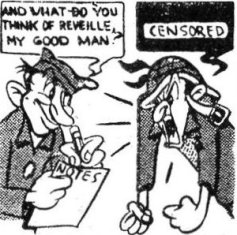
|
HALF-MAST PANTS
Stumbling out of the tent with pants at half mast, old T/7 decided to do or die for the fishwrapper and get the low-down on this thing called reveille.
After wading through a mist as thick as a Frisco afternoon, I fell in beside Pfc. Wiley Scuttlebut, 29 months out of Flatbush. Lifting the corner of his betel-stained mouth, Wiley snarled, "Two years, five months, six days, ten hours, twenty minutes and thirty seconds as a combat bulldozer, two tons of Spam, and here I am standing reveille with the war about over. Well, anything to win the peace."
I thought perhaps he was bitter. Soldiers get bitter that way after a couple or three years with only the company of machines, gibbons, lieutenants, and Roundup corn. So I leaned forward to overhear the conversation of a T/3 in the front line.
"So help me, I hope an atomic bomb lands right in the company area. That would straighten out this formation and a few other things around here. What do they want from us? Unconditional surrender?" Later I learned he had been over only 25 months and made 42 trips to Myitkyina. He was probably just bitter.
BRINGS BULLDOZER
After wallowing around in the ooze like an Indian water buffalo, the top kick got the company lined up after a fashion and dressed 'em right. Squad leaders reported, platoon leaders reported, all very military, you know, when attention was distracted by a snorting bulldozer wheeling into the ranks and sort of extending arms. Old Rumandcoke Mulligan, the zebra arm, was openly annoyed.
"No, no, Smedley," he admonished, "I know you two are inseparable, but you can't bring your bulldozer to reveille, even if you are late for work."
Crushed, Smedley jumped up to his knees in mud and sulked between two grizzly joes.
Just then the captain groped his way out of his tent, and through a beautiful pair of pink eyes, gasped when he saw the line up.
"What's the crowd for?" he excitedly inquired. "Is the war over?" Rumandcoke straightened him out, and as soon as the outfit was dismissed, old Osmosis decided to get a few opinions.
I milled among the unhappy pans to find out what they thought of his new and vital order - reveille. Strolling up to a guy called "Double Ugly," I inquired as to his candid views. Double Ugly lifted one foot out of the mud and bellowed, "I think it's a bunch of..."
Thanking him, we went on because it was easy to see he hadn't given it proper consideration. He was probably bitter, too.
FAVORS REVEILLE
Next we chanced on Luscious Q. Mudandruts, an old pipeline wallah who had strung 8,000 stalks of pipe. Mudandruts was a smart fellow. He sized up the situation like a Senate Military Affairs Committeeman.
"It's like this," the petroleum peddler confided.
"I'm in favor of reveille, only it's come two years too late. We should have had it when we were stringing that pipe. Then we wouldn't have had to get up so early."
Trying to figure out if he was bitter or not, we stumbled across Yardley S. Widebottom, an arm chair commando who's filed more papers than Scott produces.
"Whadda you think about reveille?" your weed word sniper queried. I must have said something wrong, because this guy got nasty. Oh, well, I'll keep the notes anyway; maybe I'll write a book on profanity. Come to think of it, this charley musta been bitter, too.
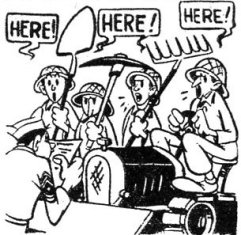
|
SMART MEDIC
Later in the day your jungle happy scribe met up with a Medic. Nice chap. Very sensible. And the only formation he's attended in 31 months has been to puncture guys' arms with his buzz needle. Anyway we thought we'd approach the thing differently with him. He was smart. Standing straight, making like a high school elocutionist. I poured out: "You've been gone two years this Spring.
"What do you think of this thing?"
Yessir, he was sharp. Quick as an MP salute, he countered with:
"Reckon not much. But way up ahead
"I tended the wounded, buried the dead.
"For I was a Medic and little we knew
"What in the future we'd go through."
It was a new angle. Could tell he was smart. Getting thirsty, old T/7 strolled over to the Red Cross shack for a sinker and a cup of steam. I sat down with seven other joes - from the seven other commands. Everything was all right 'til I absent-mindedly started humming, "Da da da, da, da, da, da, da."
I mustta chose the wrong tune. These guys stopped blowing their java and started blowing their tops.
(Editor's note: Something must have happened to our man Osmosis. This yarn was filed from the 20th General. All he keeps mumbling is, "Reveille, reveille, reveille. Even in the hospital, they have reveille, reveille, reveille.")
The Roundup is a weekly newspaper of the United States Forces, published by and for the men in Burma and India, from news and pictures supplied by staff members, soldier correspondents, Army News Service, and United Press. The Roundup is published Thursday of each week and is printed by The Statesman in New Delhi and Calcutta, India. Editorial matter should be sent directly to Major Floyd Walter, Hq., U.S.F., I.B.T., APO 885, New York, N.Y., and should arrive not later than Saturday in order to make that week's issue. Pictures must arrive by Friday and must be negatives or enlargements. Stories should contain full name and organization of sender. Complaints about circulation should be sent directly to Capt. Drexel Nixon, Base Section, APO 465, New York, N.Y. Units on the mailing list should make notification of any major change in personnel strength or any change of APO.

SEPTEMBER 6, 1945
Adapted from the original issue of India-Burma Theater Roundup
|
Notes: Because of the Special V-E Day Extra edition there were actually 53 issues in Volume 3 of Roundup, resulting in this issue being numbered 52A.
The caption of the photo of the crew who flew the Nagasaki mission correctly indicates the names of the crew of The Great Artiste. They, however, actually flew Bockscar which was already fitted for carrying the bomb. |
Copyright © 2008 Carl Warren Weidenburner
TOP OF PAGE PRINT THIS PAGE ABOUT THIS PAGE SEND COMMENTS
PREVIOUS ISSUE CLOSE THIS WINDOW NEXT ISSUE
|
|
 Paramount Pictures is grooming Lizabeth Scott for roles as a home girl, it says here. It is said she makes
delicious
apple pie. Well, the war's over, so the hell with it.
Paramount Pictures is grooming Lizabeth Scott for roles as a home girl, it says here. It is said she makes
delicious
apple pie. Well, the war's over, so the hell with it.
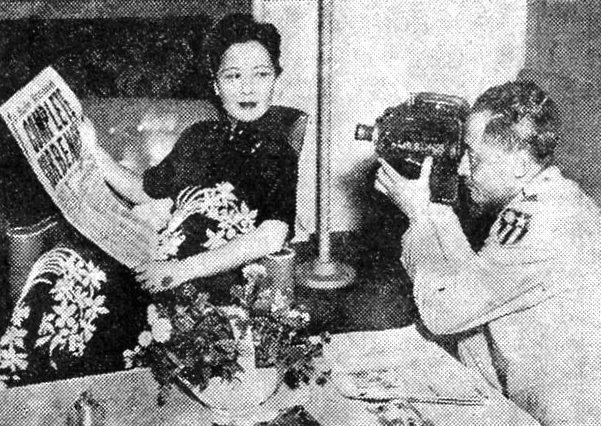 Madame Chiang Kai-shek was in New York recuperating from a recent illness when the news arrived of the Japanese surrender. On hand to photograph China's First Lady was Newsreel Wong, veteran Chinese cameraman. For both of them it was the end of eight long years of war.
Madame Chiang Kai-shek was in New York recuperating from a recent illness when the news arrived of the Japanese surrender. On hand to photograph China's First Lady was Newsreel Wong, veteran Chinese cameraman. For both of them it was the end of eight long years of war.
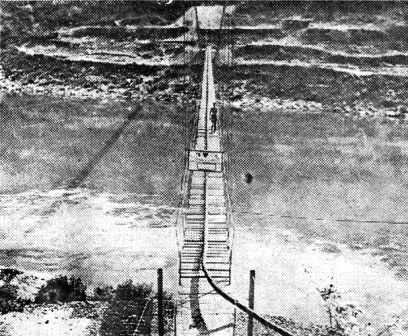 A pipeline patrolman crosses the suspension bridge built to carry the
military pipeline across the Salween gorge
in China. This bridge was built from abandoned Japanese scrap and salvaged Chinese material.
A pipeline patrolman crosses the suspension bridge built to carry the
military pipeline across the Salween gorge
in China. This bridge was built from abandoned Japanese scrap and salvaged Chinese material.
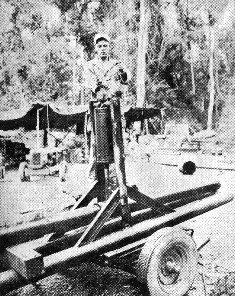 Cpl. John Blessing, Knoxville, Tenn., operates a pipe-bending machine in North Burma. This machine is used to
bend pipe in the jungle along the pipeline running from India to China. The pipe bender was completely salvaged
from discarded machine parts, resulting in a saving of several hundred dollars.
Cpl. John Blessing, Knoxville, Tenn., operates a pipe-bending machine in North Burma. This machine is used to
bend pipe in the jungle along the pipeline running from India to China. The pipe bender was completely salvaged
from discarded machine parts, resulting in a saving of several hundred dollars.
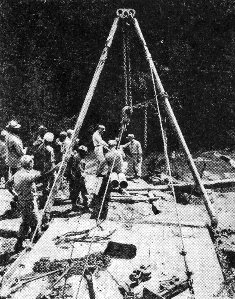 Because of transportation difficulties, pipe was carried across the Loglai River near Loglai, Burma, on a cable.
The cable is 1,000 feet long and is suspended 400 feet above the river. Two lengths of pipe are fastened to the
cable pulleys and two men ride the pipe to the opposite bank, where it is unloaded. These two men and the pipe are
just starting their 1,000-foot journey, 400 feet above the river.
Because of transportation difficulties, pipe was carried across the Loglai River near Loglai, Burma, on a cable.
The cable is 1,000 feet long and is suspended 400 feet above the river. Two lengths of pipe are fastened to the
cable pulleys and two men ride the pipe to the opposite bank, where it is unloaded. These two men and the pipe are
just starting their 1,000-foot journey, 400 feet above the river.
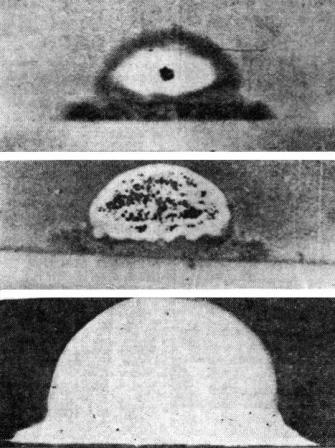 These amazing photos were taken during the initial test of the atomic bomb on the New Mexico desert. In top
picture is shown start of explosion, just a small cloud that rose later to 40,000 feet; in center, the cloud
grows bigger and takes the shape of an egg. The black in the middle was brighter than the sun itself, according to
observers. The huge cloud reached the stratosphere in about five minutes. At bottom, the tremendous cloud upheaval
appears like a white derby. Two supplementary explosions of minor effect occurred in the clouds soon after the main
explosion.
These amazing photos were taken during the initial test of the atomic bomb on the New Mexico desert. In top
picture is shown start of explosion, just a small cloud that rose later to 40,000 feet; in center, the cloud
grows bigger and takes the shape of an egg. The black in the middle was brighter than the sun itself, according to
observers. The huge cloud reached the stratosphere in about five minutes. At bottom, the tremendous cloud upheaval
appears like a white derby. Two supplementary explosions of minor effect occurred in the clouds soon after the main
explosion.
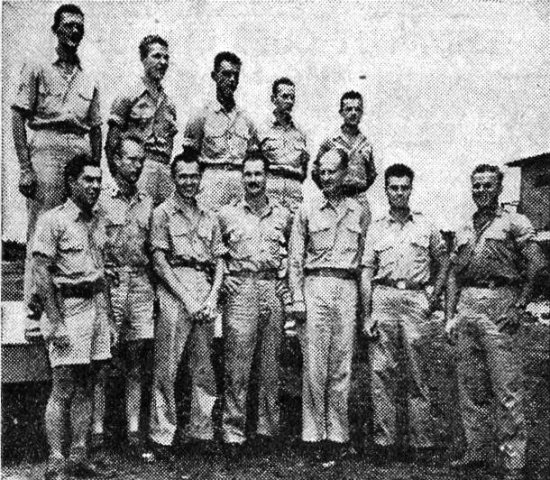 Here are crewmen of the Superfort Enola Gay, from which the first atomic bomb was dropped on Hiroshima.
Front row left to right: Lt. Jacob Beser, Baltimore, Md.; Lt. Morris Jappson, Jamestown, N.Y.; Capt. Theodore J.
Van Kirk, Northumberland, Pa.; Maj. Thomas Ferebee, Mocksville, N.C.; Capt. William Parsons, Ft. Sumner, N.M.;
Col. Paul W. Tibbets, Jr., Miami, Fla.; Capt. Robert A. Lewis, Ridgefield Park, N.J. Rear row, left to right:
Sgt. Robert R. Shumard, Detroit, Mich.; Pfc. Richard Nelson, Los Angeles; Sgt. Joe Stiborik, Taylor, Tex.; S/Sgt.
Wyatt E. Duzenbury, Lansing, Mich.; S/Sgt. George R. Caron, Lynbrook, N.Y. Ferebee was the bombardier, while Parsons
was the Navy observer.
Here are crewmen of the Superfort Enola Gay, from which the first atomic bomb was dropped on Hiroshima.
Front row left to right: Lt. Jacob Beser, Baltimore, Md.; Lt. Morris Jappson, Jamestown, N.Y.; Capt. Theodore J.
Van Kirk, Northumberland, Pa.; Maj. Thomas Ferebee, Mocksville, N.C.; Capt. William Parsons, Ft. Sumner, N.M.;
Col. Paul W. Tibbets, Jr., Miami, Fla.; Capt. Robert A. Lewis, Ridgefield Park, N.J. Rear row, left to right:
Sgt. Robert R. Shumard, Detroit, Mich.; Pfc. Richard Nelson, Los Angeles; Sgt. Joe Stiborik, Taylor, Tex.; S/Sgt.
Wyatt E. Duzenbury, Lansing, Mich.; S/Sgt. George R. Caron, Lynbrook, N.Y. Ferebee was the bombardier, while Parsons
was the Navy observer.
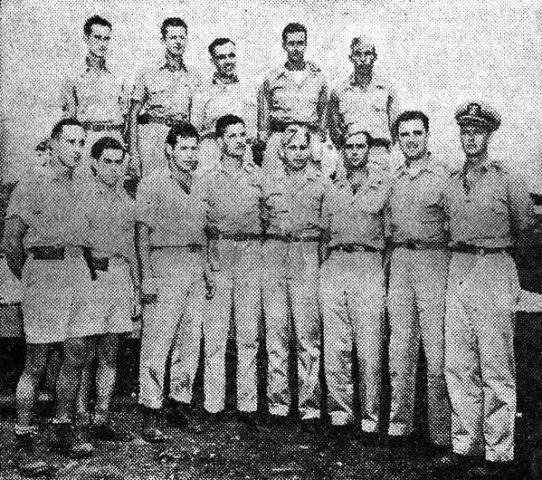 These are the crewmen of the B-29 The Great Artiste, who dropped the second atomic bomb on Nagasaki.
Front row, left to right: Lt. Philip Barnes, Manistique, Mich.; Lt. Jacob Beser,
Baltimore, Md.; Lt. Fred J. Olivi,
Chicago, Ill.; Capt. Kermit Beahan, Houston, Tex.; Lt. Charles Albury, Miami, Fla.; Capt. James F. Van Pelt,
Oak Hill, W. Va.; Maj. Charles W. Sweeney, North Quincy, Mass.; Cmdr. Frederick L. Ashworth, Wendham, Mass.
Back row, left to right: M/Sgt. John D. Kuharek,
Columbus, Neb.; Sgt. Abe M. Spitzer, Bronx, N.Y.; Sgt. Raymond Gallagher, Chicago, Ill.; S/Sgt. Edward K. Buckley,
Lisbon, O.; S/Sgt. Albert T. DeHart, Plainview, Tex. Beahan was the bombardier, while Ashworth was a Navy observer.
These are the crewmen of the B-29 The Great Artiste, who dropped the second atomic bomb on Nagasaki.
Front row, left to right: Lt. Philip Barnes, Manistique, Mich.; Lt. Jacob Beser,
Baltimore, Md.; Lt. Fred J. Olivi,
Chicago, Ill.; Capt. Kermit Beahan, Houston, Tex.; Lt. Charles Albury, Miami, Fla.; Capt. James F. Van Pelt,
Oak Hill, W. Va.; Maj. Charles W. Sweeney, North Quincy, Mass.; Cmdr. Frederick L. Ashworth, Wendham, Mass.
Back row, left to right: M/Sgt. John D. Kuharek,
Columbus, Neb.; Sgt. Abe M. Spitzer, Bronx, N.Y.; Sgt. Raymond Gallagher, Chicago, Ill.; S/Sgt. Edward K. Buckley,
Lisbon, O.; S/Sgt. Albert T. DeHart, Plainview, Tex. Beahan was the bombardier, while Ashworth was a Navy observer.
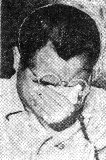 Realization of defeat was more than this Jap prisoner could bear. As Hirohito broadcast Nippon's capitulation,
this honorable subject burst into tears.
Realization of defeat was more than this Jap prisoner could bear. As Hirohito broadcast Nippon's capitulation,
this honorable subject burst into tears.
